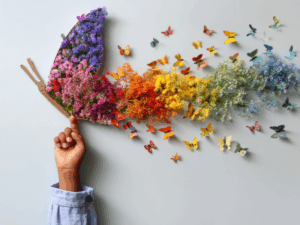
Identity After Sexual Trauma: Finding Yourself Again
Identity After Trauma: When You’re Not Sure Who You Are Anymore
Part 3 of the “Questions Nobody Asks Out Loud” Series
Alright, let’s talk about the question that keeps you up at 3am, the one you’ve Googled a hundred times in different ways, hoping for an answer that makes sense.
“Am I gay/bi/straight/something else because of what happened to me? Or is this who I really am?”
“What if I want to transition… is that trauma talking, or is that actually me?”
“How do I know what’s real and what’s just… broken?”
These are the questions that sit in your chest like a stone. The ones you can barely form into words, even in your own mind. Because what if asking the question somehow confirms your worst fear—that you don’t actually know who you are?
Here’s what I want you to hear before we go any further: Trauma doesn’t create your identity. But it can absolutely confuse you about your identity.
And figuring out the difference? That’s some of the hardest, most important work you’ll ever do.
Let’s dive in.
In This Post:
- Whether sexual abuse can change your sexual orientation
- Gender identity questions after trauma
- How to know what’s trauma response vs. authentic self
- Why you need to heal your body before you can see clearly
- The “trying on identities” phase and why it’s okay
- Biblical perspective without shame or condemnation
The Questions Nobody Asks (But Everyone Wonders)
Question 1: “Am I gay/bi/queer because of the abuse? Did it make me this way?”
This is the question that haunts survivors. And the answer is both simpler and more complex than you might think.
No, childhood sexual abuse does not cause homosexuality or change your inherent sexual orientation.
But—and this is important—abuse can absolutely create confusion about your sexual orientation.
Here’s why:
Your first sexual experiences were traumatic. If abuse was your introduction to sexuality, your brain doesn’t have a clean reference point for what attraction, desire, or intimacy actually feel like. Everything got tangled up with fear, powerlessness, and survival.
The gender of your abuser matters in confusing ways. If you were abused by someone of the same gender, you might wonder: “Did that awaken something in me? Or did it traumatize me in ways that are now confusing my attractions?” If you were abused by someone of the opposite gender, you might find yourself repelled by that gender and more comfortable with the same gender—but is that authentic attraction or trauma avoidance?
Trauma can make you seek safety in unexpected places. Some survivors feel safer with the same gender because abuse came from the opposite gender. Some feel safer with the opposite gender because abuse came from the same gender. Safety and attraction can get confused when your nervous system is just trying to avoid more pain.
Shame distorts everything. If you grew up in an environment where being gay was considered sinful or wrong, and then abuse happened, your brain might latch onto “maybe I’m gay and that’s why this happened” as a twisted way of making sense of the senseless.
“The question isn’t whether trauma can create sexual orientation. The question is: can you see your authentic self clearly while trauma is still distorting the lens?”

Question 2: “What about gender identity? Can trauma make me trans or non-binary?”
Another deeply personal, incredibly complex question.
Trauma doesn’t create gender dysphoria. But trauma can make you want to escape your body—and that can look like gender dysphoria.
Let me explain the difference:
Authentic gender dysphoria is a persistent, long-term sense that your gender identity doesn’t match your biological sex. It’s about who you are at your core, separate from what happened to you.
Trauma-related body disconnection is desperately wanting to escape the body that was violated. It’s “I hate this body because of what happened to it” or “If I weren’t female/male, maybe I would have been safe.”
Here’s where it gets tricky: both can feel like “I don’t want to be in this body.” Both can lead to wanting to change or reject your body. But the root cause—and therefore the path to healing—is different.
Signs it might be trauma-related body rejection:
- The feelings intensified after the abuse or after remembering the abuse
- You specifically want to escape the gendered aspects of your body that were targeted in abuse
- You fantasize about being the opposite gender primarily as a way to feel safe, not as a core identity
- The distress lessens when you’re healing trauma and feeling safer in your body
Signs it might be authentic gender identity:
- You’ve felt this way consistently since early childhood, before abuse occurred
- The dysphoria isn’t primarily connected to feeling unsafe—it’s about feeling fundamentally misaligned
- Even when you feel safe and healed from trauma, the gender incongruence remains
- Exploring your gender identity brings relief and clarity, not just escape
Here’s the nuance nobody talks about: It’s possible for both to be true.
You could genuinely be trans or non-binary and have experienced trauma. Trauma doesn’t invalidate authentic gender identity. And having authentic gender dysphoria doesn’t mean you can skip healing your trauma.
Critical Insight:
You cannot make permanent identity decisions from a traumatized nervous system.
When your body is stuck in survival mode, everything looks like a threat—including your own body. Healing your relationship with your body has to come before you can see clearly who you actually are underneath the trauma.
This doesn’t mean “wait forever” or “suppress your identity.” It means: do the trauma work while you explore, not instead of exploring.

Question 3: “How do I know what’s really me versus what trauma made me believe?”
This is the million-dollar question. And I wish I could give you a simple test, but identity work is rarely simple.
Here’s what I can tell you:
Trauma responses are characterized by:
- Fear (this keeps me safe)
- Avoidance (this helps me escape what hurt me)
- Confusion (I genuinely don’t know what I want or feel)
- Reactivity (this is the opposite of what hurt me, so it must be right)
- Instability (my sense of identity shifts dramatically based on who I’m with or how I’m feeling)
Authentic identity is characterized by:
- Consistency (this has been true about me across time and context)
- Peace (when I honor this about myself, I feel more whole, not less)
- Clarity (this makes sense of my life in a way that feels true, not forced)
- Internal alignment (this isn’t about pleasing others or protecting myself—it’s just… me)
Here’s the process I recommend:
Step 1: Heal your relationship with your body first.
You can’t know who you are if you’re dissociated from your body or actively at war with it. Work on feeling safe in your body. Learn nervous system regulation. Address the trauma that’s making your body feel like enemy territory.
(This is exactly what I walk through in Healing What Hides in the Shadows and in my coaching work—reclaiming your body before trying to make big identity decisions.)
Step 2: Give yourself permission to explore without committing.
You’re allowed to try on different identities, different labels, different expressions of yourself. This isn’t lying or being fake—it’s learning. Some things will feel right. Some won’t. That’s information.
Step 3: Notice what brings peace versus what brings relief.
Relief is temporary. “If I just do this, the pain will stop.” Peace is deep. “This aligns with who I am, even if it’s hard.”
Step 4: Work with a trauma-informed therapist or coach.
Someone who understands both trauma and LGBTQ+ issues. Someone who won’t push you toward or away from any particular identity, but will help you sort through what’s yours and what’s trauma’s.
Step 5: Take your time.
You don’t have to decide today. You don’t have to announce anything. You don’t have to make permanent changes right now. Healing takes time. Clarity takes time. Give yourself that gift.
Want to Go Deeper?
In Healing What Hides in the Shadows, you’ll find:
- Body-based practices for reconnecting with yourself
- Nervous system tools to create safety within
- Guidance on separating trauma from authentic identity
- No pressure to have it all figured out

Question 4: “What does the Bible say about all this? Am I sinning by questioning my identity?”
If you come from a faith background, this question probably weighs on you heavily. So let me offer some perspective rooted in grace and truth.
First: You are not sinning by having questions.
Wrestling with your identity after trauma isn’t rebellion. It’s not lack of faith. It’s not evidence that you’re far from God. It’s evidence that you’re human and you’re hurting and you’re trying to make sense of something devastating.
God doesn’t condemn you for asking hard questions. He’s big enough to handle your confusion.
Second: Healing your body is not optional—it’s stewardship.
Your body is God’s creation. Trauma violated that creation. Healing your relationship with your body—learning to feel safe in it, to honor it, to listen to it—is part of stewarding what God gave you.
You can’t honor God with a body you’re dissociated from or actively trying to escape.
Third: Identity questions don’t disqualify you from God’s love.
Whether you’re questioning your sexual orientation, your gender identity, or anything else about yourself—God’s love for you hasn’t changed. You are still His. You are still worthy. You are still seen and known.
The enemy wants you to believe that your questions make you unredeemable. That’s a lie straight from hell.
Fourth: The “wait and see” approach is wise, not weak.
If you’re not sure what’s trauma and what’s authentic identity, it’s okay to say: “I don’t know yet. I’m going to heal first, then reevaluate.”
That’s not suppressing yourself. That’s wisdom. That’s giving yourself the gift of clarity before making permanent decisions.
Fifth: God’s design for sexuality and identity is real—and so is trauma’s impact.
I believe God created us male and female, with sexuality designed for marriage between man and woman. I also believe trauma can deeply distort how we experience our bodies, our gender, and our sexuality.
Both things can be true. And navigating the tension between them requires grace, time, and support—not shame.
“You don’t have to choose between being honest about your struggle and being faithful to God. He invites you to bring all of it—the questions, the confusion, the pain—into His presence.”
Question 5: “What if I’m ‘trying on’ different identities? Does that make me fake?”
No. It makes you wise.
Here’s what most people won’t tell you: figuring out your identity after trauma is like trying to see your reflection in a shattered mirror. The pieces are all there, but they don’t form a coherent picture yet.
So you pick up pieces. You try them on. You see what fits.
Some survivors try on different identities to:
- Feel safer (maybe being seen as masculine/feminine/androgynous protects me)
- Belong somewhere (maybe this community will accept me)
- Understand themselves (maybe this label explains what I’m feeling)
- Escape shame (maybe if I’m this instead of that, I won’t feel so dirty)
And here’s what’s true: Some of what you try on will fit. Some won’t. That’s not failure—that’s discovery.
You might identify as bisexual for a while and later realize you’re actually straight, but trauma made intimacy with men feel unsafe. That’s not being fake—that’s healing.
You might explore non-binary identity and realize that what you really needed was permission to reject rigid gender roles that felt constraining after abuse. That’s not being fake—that’s growth.
You might come out as gay, then later realize you were trying to escape relationships with the gender that hurt you. Or you might come out as gay and realize this was always true, and abuse just confused you about it. Both are valid journeys.
The point isn’t to get it right immediately. The point is to give yourself grace while you figure it out.

Question 6: “Will I ever actually know who I am?”
Yes. But not from where you’re standing right now.
Right now, you’re looking at yourself through a lens that trauma smudged, cracked, and distorted. You’re trying to see clearly through fog.
Here’s what happens as you heal:
The fog lifts. As you do trauma work, regulate your nervous system, and feel safer in your body, the confusion starts to clear. What felt overwhelming and impossible to sort through starts to make sense.
Your authentic self emerges. Underneath the survival strategies, the shame, the fear, the confusion—there’s a you that was always there. Healing doesn’t create you. It reveals you.
Peace replaces panic. When you finally land on what’s true about you—whether that’s your sexual orientation, gender identity, or any other aspect of yourself—it won’t feel like you’re white-knuckling a decision. It’ll feel like coming home.
You stop asking permission. Healed identity doesn’t need external validation to exist. You know who you are, and you trust that knowing—even if others don’t understand it.
This doesn’t happen overnight. It takes time. It takes patience with yourself. It takes doing the hard work of trauma recovery so you can see clearly.
But I promise you—the clarity is worth the wait.
The Bottom Line
If you’re questioning your sexual orientation after trauma, that’s normal.
If you’re questioning your gender identity after trauma, that’s normal.
If you’re confused about who you really are versus who trauma made you believe you are, that’s normal.
None of this makes you broken. It makes you someone trying to find themselves after something terrible tried to erase you.
“Trauma doesn’t create your identity. But it can make you forget who you were before it happened—and that means healing has to come before clarity can.”
You’re allowed to take your time. You’re allowed to not know yet. You’re allowed to explore without committing. You’re allowed to change your mind as you heal.
And you’re allowed to trust that underneath all the confusion, there’s a you that’s real, that’s whole, that’s waiting to be discovered.
Ready to Find Yourself Again?
You don’t have to navigate this alone.
Read the Book
Healing What Hides in the Shadows offers body-based tools for reconnecting with your authentic self.
Get the Book
Work With Me
One-on-one coaching for survivors navigating identity, sexuality, and healing after trauma.
Learn About Coaching
Stay Connected
Join honest conversations about identity, trauma, and healing—without shame.
Subscribe
Read the Full Series:
Part 1: The Questions You’re Afraid to Ask About Your Body – Arousal, body memories, dissociation, and feeling broken
Part 2: Let’s Talk About Porn, Shame, and Control – Why trauma survivors struggle with sexuality
Related Posts:
- Why Your Body Hasn’t Gotten the Memo That You’re Safe
- Breaking the Silence: How to Talk About Childhood Sexual Abuse
- Teaching Your Body It’s Safe: Practical Tools
One in three girls and one in six boys experience sexual abuse before age 18. Many question their identity afterward. But confusion doesn’t mean you’re broken—it means you’re healing.
Your questions are valid. Your journey is yours. And clarity is possible.



Recent Comments